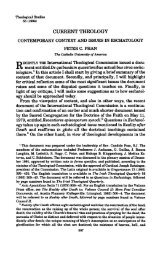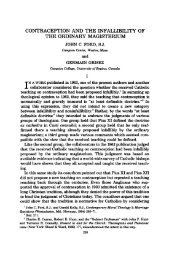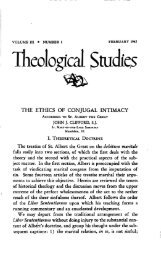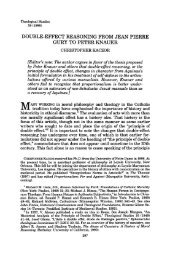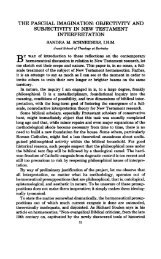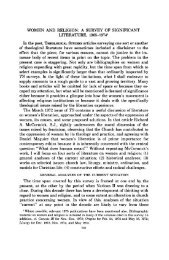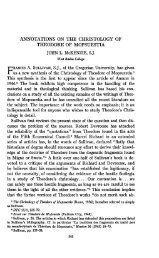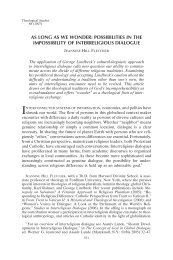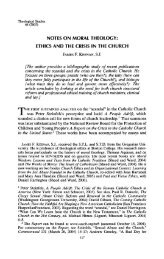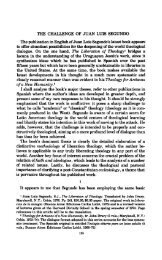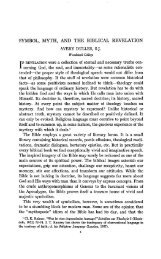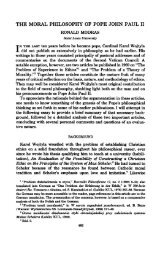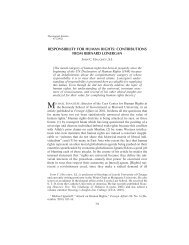episkopë and episkopos: the new testament evidence - Theological ...
episkopë and episkopos: the new testament evidence - Theological ...
episkopë and episkopos: the new testament evidence - Theological ...
Create successful ePaper yourself
Turn your PDF publications into a flip-book with our unique Google optimized e-Paper software.
338 THEOLOGICAL STUDIES<br />
Jn 10, where <strong>the</strong> presbyter deals with Diotrephes who rejects his authority,<br />
<strong>the</strong> most he can do is to threaten "to bring up" before <strong>the</strong> community<br />
what Diotrephes is doing. All of this makes sense in light of Jn 14:26,<br />
where <strong>the</strong> Paraclete is <strong>the</strong> one who teaches <strong>the</strong> Christian all things, <strong>and</strong><br />
every Christian possesses <strong>the</strong> Paraclete. The author of <strong>the</strong> Epistles can<br />
speak as part of a "we" who are <strong>the</strong> witnesses to <strong>the</strong> Johannine tradition<br />
(1 Jn 1:1-4) <strong>and</strong> thus join himself to <strong>the</strong> witness of <strong>the</strong> Beloved Disciple;<br />
but he cannot present himself as a teacher, as his opponents seem to be<br />
doing. And if his opponents also claim to possess an anointing by <strong>the</strong><br />
Spirit, all he can respond is, "Test <strong>the</strong> Spirits" (1 Jn 4:1). When <strong>evidence</strong><br />
for stricter authority appears in <strong>the</strong> Johannine writings, namely, in 3 Jn,<br />
that authority is in opposition to <strong>the</strong> presbyter. The Diotrephes of 3 Jn<br />
9-10 is making himself first in <strong>the</strong> local Johannine church, seemingly<br />
along <strong>the</strong> lines of <strong>the</strong> episcopal style advocated in <strong>the</strong> letters of Ignatius<br />
of Antioch; <strong>and</strong> he is not allowing <strong>the</strong> presbyter to send emissaries into<br />
<strong>the</strong> church. Some have thought that Diotrephes was propounding false<br />
doctrine; but <strong>the</strong> epistolary author, who is so hard on <strong>the</strong> secessionists,<br />
offers no doctrinal critique of Diotrephes. The latter may have been on<br />
<strong>the</strong> same side doctrinally as <strong>the</strong> presbyter, but may have realized that<br />
<strong>the</strong> presbyter's trust that people would be led to <strong>the</strong> truth by <strong>the</strong> Spirit<br />
was not working (as 1 Jn 4:5 concedes). Thus, from 3 Jn <strong>and</strong> from Jn 21<br />
(Peter as <strong>the</strong> shepherd) we may suspect that greater supervisory power<br />
of <strong>the</strong> presbyter-bishop type, although foreign to <strong>the</strong> <strong>the</strong>ological genius<br />
of <strong>the</strong> Johannine community, was introduced over opposition into segments<br />
of that community in order to resist false teaching.<br />
This survey shows that <strong>the</strong> manner <strong>and</strong> exercise of supervision varied<br />
greatly in <strong>the</strong> different places <strong>and</strong> different periods within <strong>the</strong> first<br />
century or NT era. Only at <strong>the</strong> end of <strong>the</strong> century <strong>and</strong> under various<br />
pressures was a more uniform structure of church office developing. The<br />
death of <strong>the</strong> great leaders of <strong>the</strong> early period in <strong>the</strong> 60's left a vacuum;<br />
doctrinal divisions became sharper; <strong>and</strong> <strong>the</strong>re was a greater separation<br />
from Judaism <strong>and</strong> its structures. By <strong>the</strong> βΟ'β-ΘΟ'β <strong>the</strong> presbyter-bishop<br />
model was becoming widespread, <strong>and</strong> with <strong>the</strong> adjustment supplied by<br />
<strong>the</strong> emergence of <strong>the</strong> single bishop that model was to dominate in <strong>the</strong><br />
second century until it became exclusive in <strong>the</strong> ancient churches. Many<br />
of us see <strong>the</strong> work of <strong>the</strong> Holy Spirit in this whole process, but even those<br />
who do must recognize that <strong>the</strong> author of 1 Clement is giving overly<br />
simplified history 35 when he states (1 Clem. 42) that <strong>the</strong> apostles (seemingly<br />
<strong>the</strong> Twelve) who came from Christ appointed <strong>the</strong>ir first converts to<br />
be bishops <strong>and</strong> deacons in local churches.<br />
35<br />
There are o<strong>the</strong>r instances of this in 1 Clement. Although <strong>the</strong> author seems to know<br />
most of <strong>the</strong> Pauline letters, <strong>and</strong> although Paul speaks with scarcely veiled contempt of "<strong>the</strong><br />
so-called pillars" of <strong>the</strong> Church (James, Cephas/Peter, John), 1 Clem. 5:2-4 does not<br />
hesitate to designate Peter <strong>and</strong> Paul as "most righteous pillars" of <strong>the</strong> Church!



